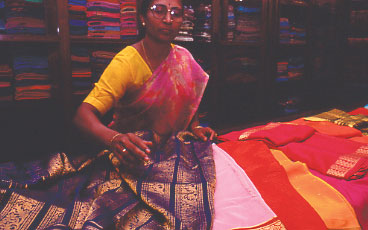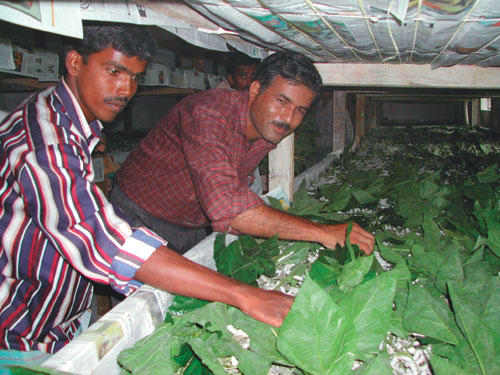Japan's Official Development Assistance White Paper 2005
Column II-9 Japan's Sericulture Technology Woven into Saris

An Indian woman wearing a sari (Photo: JICA)
The sari, the traditional national costume for Indian women, is a single strip of cloth approximately 120cm wide and 5 to 9 meters long worn by wrapping it around the body over a blouse and petticoat. It is usually made from cotton and sheep's wool and so on, but many women yearn for a silk one. Because of the sustained and steady economic growth in recent years, the population of middle-income earners has grown in India, and the number of women wanting a high-quality silk sari has also increased. India boasts the second-highest production of raw silk in the world after China. However, Indian-made raw silk is so weak and breaks so easily that it is thought to be unsuitable for sari and other silk garments. As a result, India has been importing 10,000 tons of raw silk each year from China and other countries. To improve this situation, the government of India who aims to become self-sufficient in raw silk, has begun challenging to increase domestic production and improve the quality of Indian silk. India has made a request to Japan for technical assistance in the field of sericulture.
Most of the silkworms traditionally bred in India hatch three or more times a year. The yield of the cocoon and the quality of the raw silk of this type are much worse than those of the bivoltine ones (hatching twice a year in their natural state) bred in Japan and China. So Japan has been providing technical cooperation in an attempt to develop bivoltine silkworms suitable for India's climate and disseminate bivoltine sericulture technology, which could make India self-sufficient in high-quality raw silk and raise the incomes of silk farmers and traders. To the dissemination of bivoltine sericulture, India's traditional sericulture manner has been an obstruction. Because bivoltine silkworm is easily affected by infectious diseases, it is indispensable to sterilize the hatchery constantly. Nonetheless, habitually, Indian people have neglected sterilization. Moreover, some of the farmers believe that the excrements of the cow, a sacred animal in the Hindu religion, prevent silkworms from getting sick, so they spread these on the dirt floor of the hatchery. Recently, thanks to the guidance of Japanese experts, many farmers have abandoned these centuries-old practices. They have begun constructing hatcheries equipped with ventilation shafts and nets to keep flies away, and have begun diligent sterilization.

Employee at the Technical Service Center training a local farmer (Photo: JICA)
Sericulture was formerly one of the major industries in Japan. But under pressure from imported products made in countries with lower labor costs, Japan's world-famous sericulture industry declined. It is this Japanese sericulture technology that now spreads to southern India. A farmer who has been producing bivoltine cocoons for three years is very motivated, saying, "Above all, I am happy about my cash income increasing. Now I have extra work to do, such as sterilization which I hadn't done before, but the benefits outweigh the costs. I have already repaid the loan for building the new hatchery. Next year I want to expand my operations further."


 Next Page
Next Page